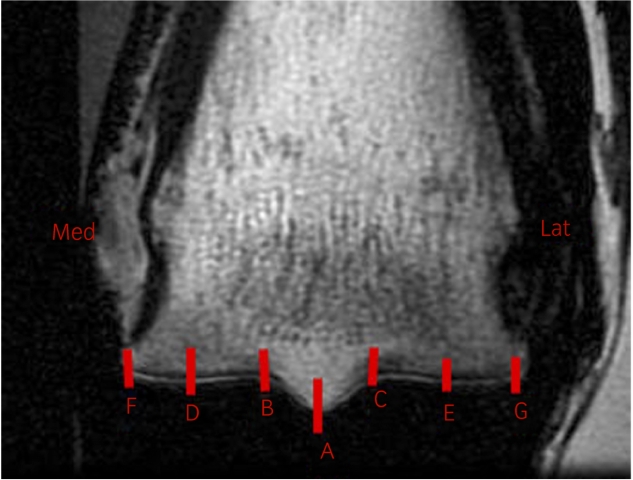
Increases in subchondral bone thickness measured from MRI images were associated with increased fracture risk.
New Podcast Discusses Science Of Prediction To Prevent Racehorse Injuries
If injuries in racehorses can be predicted there is a far greater chance they can be prevented suggests the latest podcast in the Equine Veterinary Journal (EVJ) collection http://apple.co/1KnWqX7 . In the 45 minute orthopaedic-themed broadcast Dr Tim Parkin discusses the advantages of early MRI detection of bone changes, which occur prior to catastrophic limb fracture and Dr Sarah Plevin talks about the possible relationship between sesamoiditis, subclinical suspensory ligament branch change and suspensory ligament branch injury in yearling Thoroughbreds.
Fracture of the lateral condyle of the third metacarpus (MC3) is the most common reason for euthanasia on the racecourse, while suspensory branch ligament injury is a frequent stumbling block in yearling thoroughbreds in the initial months of training. In the podcast Dr Parkin and Dr Plevin both explain the potential advantages of early intervention to prevent injury and maintain racing performance.
Dr Tim Parkin of Glasgow University Veterinary School explores the question Can we use subchondral bone thickness on high-field magnetic resonance images to identify Thoroughbred racehorses at risk of catastrophic lateral condylar fracture?1 The study, which assessed the bone-level risk factors for fracture in racehorses, is part of long-standing programme of research to prevent racehorse injury, funded by the Horserace Betting Levy Board (HBLB).
A total of 191 MC3s from 96 horses with (47) and without (49) lateral condylar fracture, were subjected to MR imaging. Greater depth of dense subchondral/trabecular bone in the palmar half of the lateral parasagittal groove of distal MC3 was associated with an increased likelihood of being from a horse that had sustained a fracture. The identification of markers for pre fracture change, that can be detected using MRI, suggests that reliable screening methods for fracture risk may be developed. The routine use of such screening programmes would enable the introduction of interventions, such as alterations to training regimens based on known risk factors for lateral condylar fracture that may reduce the likelihood of fracture in susceptible horses.
Sarah Plevin of Florida Equine Veterinary Associates, Ocala, Florida continues the podcast with a discussion about Association between sesamoiditis, subclinical ultrasonographic suspensory ligament branch change and subsequent clinical injury in yearling Thoroughbreds.2
Sesamoiditis is a common radiological finding in yearling Thoroughbreds. The condition is believed to be associated with suspensory ligament branch injury (SLBI), which is known to affect racing performance. The observational study evaluated 50 untrained yearling Thoroughbreds at a training centre. The results identified a significant relationship between significant grades of sesamoiditis, subclinical suspensory ligament branch change (SSLBC) and subsequent suspensory ligament branch injury (SLBI). The associations highlight the importance of ultrasonographic examination of suspensory ligament branches in horses with significant grades of sesamoiditis. Ultimately the findings could allow more accurate prognoses to be made regarding the development of SLBI and provide opportunity for intervention and prevention of such injury.
Professor Celia Marr, Editor of the Equine Veterinary Journal said: “Major advances in diagnostic imaging mean that we are increasingly able to deploy predictive science in order to prevent serious injury. Important studies such as these and others supported by the HBLB are giving us real potential to rule out horses at risk and thus reduce significantly some of the welfare concerns in the horseracing world.”
The EVJ podcast archive is available free at: http://apple.co/1KnWqX7 .
The papers are available at http://onlinelibrary.wiley.com/doi/10.1111/evj.12574/full and http://onlinelibrary.wiley.com/doi/10.1111/evj.12497/full
References
1Can we use subchondral bone thickness on high-field magnetic resonance images to identify Thoroughbred racehorses at risk of catastrophic lateral condylar fracture? C. A. Tranquille, R. C. Murray,T. D. H. Parkin DOI: 10.1111/evj.12574
2Association between sesamoiditis, subclinical ultrasonographic suspensory ligament branch change and subsequent clinical injury in yearling Thoroughbreds. S. Plevin, J. McLellan, T. O'Keeffe DOI: 10.1111/evj.12497
More from BEVA

 9 years ago
9 years ago  1354 views
1354 views

 19 hours ago
19 hours ago